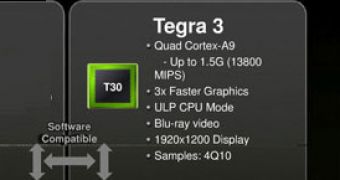Before the end of the ongoing year, we should be able to see on the market the first mobile devices packing quad-core application processors, but they won't be smartphones, it seems.
Nvidia is the company to supply the said chips, and their President and Chief Executive Officer, Jen-Hsun Huang, has just confirmed that, while tablet PCs to pack the powerful SoC will certainly be launched before the end of the year, smartphones are far less likely to share the same fate.
Previously, the company seemed convinced about the availability of quad-core powered smartphones in 2011, but now the company does not seem as sure about it, Forbes reports.
Quad-core tablets, however, are another story. The first of them should make an official appearance during the fourth quarter of the ongoing year, or even during the third quarter, though there are only about three weeks left of it.
Nvidia is aiming at having the new application processors available on the market before rival companies do, specifically before Qualcomm.
The latter has a long tradition of supplying mobile phone makers with chips for their devices, including application processors and radio chips, and Nvidia has a powerful rival to fight with.
“We’re the only people seriously on the dance floor with Qualcomm,” contends Huang. “We’re really the only two active players [in the high-end mobile processor market].”
Nvidia has already announced its first quad-core application processor for the mobile market, the Tegra 3 chip, also known as Kal-El, and this is the SoC that should be packed inside the first quad-core smartphones.
Unfortunately, the company did not offer specific info on why only tablet PCs packing the chip are expected to arrive on shelves this year. However, if we were to guess, we should say that it might have something to do with the battery life users can enjoy.
Tablet PCs pack high capacity batteries, while smartphones have smaller ones, which would be drained fast by a power-hungry quad-core CPU.
Of course, Nvidia might have optimized the SoC to eat as less power as possible, but battery drain is still one of the most commonly encountered issues with smartphones.
At the same time, there is the problem of having applications scale on four cores, and we can only imagine that they are not that many mobile apps optimized for this.
One way or the other, Nvidia will certainly announce more on when the first quad-core smartphones based on Kal-El are to arrive on shelves in the next several months, so don't forget to check back for updates.

 14 DAY TRIAL //
14 DAY TRIAL //